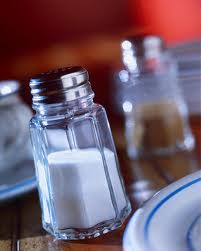Navigating Your Salt Choices:

On the shelves at grocery stores or specialty markets you might see more than one choice; table salt, fleur de sel, sea salt, Kosher salt and salt substitutes (Mrs. Dash, No Salt, etc.). How do you know which one to choose? Just know that all of the different types of salt will provide the same amount of sodium, the cause of health issues. The only exception will be your salt substitutes since they are manufactured for people who have high blood pressure or heart disease. Some people like to state that sea salt is “natural” and a “healthier alternative” but just know it will cause the same effects as regular table salt. Even the fancy pink, grey and finishing salts are all basically the same; they just have a different flavor depending on where they were harvested from.
Some sources of salt can be hard to find if you don’t know the scientific language used on food labels. Monosodium glutamate, sodium chloride, monosodium chloride are all sources of salt. It can be found in soy sauce, baked goods, cheese and canned goods. Beware of the choices you make daily. Choose lower salt or no salt varieties when offered, especially with canned goods. Or, if you are able, prepare your own foods. This allows you to control the amount of salt added to recipes. Avoid placing the salt shaker on the dinner table, for some the temptation is too strong to resist.
The recommended daily intake of salt is 2,400 mg, which is about the size of 1 teaspoon. For people who have high blood pressure, the recommended daily intake is 1,500 mg, which is about the size of 2/3 teaspoon. There are other ways to make foods tasty without adding salt. By using different herbs and spices, the flavor of foods can be intensified and you can be kinder to your health. The National Heart, Lung and Blood Institute has a great website to pair meats (mind the pork) and vegetable with healthy flavorings.
If you are a marathon runner or ultra-athlete, you may need to increase the amount of salt you take in per day, but it differs between individuals. If you sweat excessively, exercise in the heat and have very salty skin when finished you shouldn’t limit the amount of salt you take in daily. Just know that you won’t replace the salt lost with sports drinks, they are actually higher in water. After the extreme sweating just have a meal that is higher in salt to help replace what was lost. Salt is found everywhere in the world and has been linked to major health problems. You can help by arming yourself with the knowledge of reading food labels, knowing how much you take in daily and how to substitute for extra flavor.